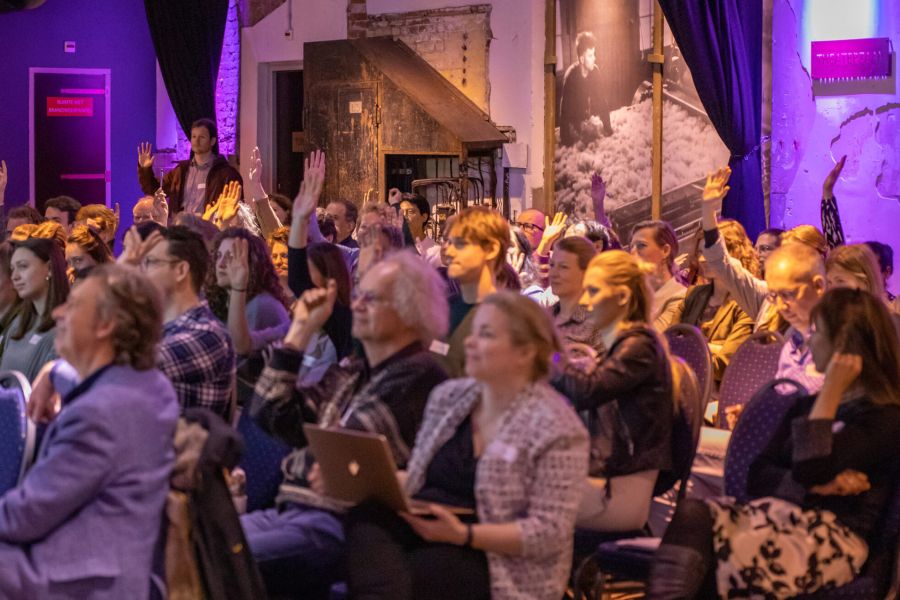Gather all rhythms! – The first Dutch Chronobiology Meeting

By Anneloes Opperhuizen – Photography by Hans van Kooten
It has been 6 years since Dutch chronobiologists in the Netherlands had gathered for a scientific meeting. The OnTime consortium ran at that time during which annual meetings were extended towards national meetings. After the end of OnTime, national gatherings did not take place, until now. Initiated by the BioClock consortium, we organized the first annual Dutch Chronobiology Meeting last April 17th in Leiden. With 120 participants from across the country, we were impressed by the interest for this meeting. Joke Meijer, coordinator of BioClock: “I am very proud of this research community. As BioClock, we took the initiative to organize this day but both in the program as in the audience, fifty percent of the people are from outside of the consortium. This indicates how large the research field of biological rhythm is in the Netherlands.”
“I am very proud of this research community. A day like this shows how large the research field of biological rhythm is in the Netherlands.” – prof. Joke Meijer, BioClock coordinator






The morning session was kicked of by dr. Femke Rutters (Amsterdam UMC) presenting her work as epidemiologist on the interaction between sleep, nutrition, exercise and health. The indication that specific (afternoon) timing of exercise may be beneficial for patients with diabetes type 2 is one of the foremost results that may be almost ready to use in the clinic.
“There is still very little overlap between ecology and chronobiology, that is a pity, a missed opportunity” – prof. Theunis Piersma (Royal Netherlands Institute for Sea Research, RUG)
As the field of chronobiology ranges from all aspects in biology, the next speaker, and Spinoza laureate, prof. Theunis Piersma (RUG and NIOZ) spoke about the interaction between biological rhythms and ecology. With his research into migratory shorebirds (red knot and spoonbills), he showed that they can migrate enormous distances. Additionally, those birds adjust their seasonal rhythms as well as circadian rhythms of behavior depending on the season. Do they need to breed or migrate? It turns them into nocturnal or diurnal animals respectively.

Followed by psychologist dr. Niki Antypa (Leiden University) explaining us on the complex relationship between circadian rhythms and mental health. Which comes first, in which of the symptoms does it play a role and how important is sleep as a modulator of those aspects? Late chronotypes seem to have a disadvantage in the risk to develop depression and the chance to respond well to treatment. Her talk was followed by dr. Milena Schönke (LUMC) and Ayano Shiba (NIN, BioClock PhD) presenting their work on rodents and the interaction between timing of exercise and metabolic health. Improved glucose values, reduced inflammation markers and a healthier microbiome when running was restricted to a selected time of the day.
With a lunch break combined with a poster session, we prepared for the afternoon session during which prof. Roelof Hut (University of Groningen) presented how stress (corticosterone) acts as a Zeitgeber for circadian rhythms in the body, specifically peripheral rhythms. He plead for the fact that stress is not only a bad thing, but is actually essential for a healthy circadian system.
“Stress is a protective mechanism for our circadian system” – prof. Roelof Hut (RUG)
“Stress is a protective mechanism for our circadian system” – prof. Roelof Hut (RUG)





Dr. Imre Kouw (Wageningen University) and dr. Jan-Frieder Harmsen (University Maastricht) next presented their work on the importance of intermittent feeding schedules in ICU patients and natural daylight in diabetic patients. Kouw demonstrated how feeding with an interval did not negatively affect the glucose values of patients, which could be beneficial for recovery. Harmsen showed the improvement of glucose values after exposure to daylight instead of artificial office light, an unhealthy situation for the human biological clock.
Co-coordinator of BioClock, dr. Laura Kervezee (LUMC) presented how metabolites are affected by night shifts in police officers with a main change in metabolites related to the immune system and fat metabolism. Anouk van Beurden (LUMC) and Tamara Brouwers (RIVM, BioClock PhD) closed the session with their research on the potential of CEM3 to improve dampened rhythms, or the time of Sars-CoV2 vaccination to increase immunity, respectively.





Hereafter, it was time for the keynote lecture by prof. dr. Till Roenneberg (LMU). He mentioned that “this day is a great reminder on why -he – likes chronobiology so much”. He inspired us with a story on the relationship on circadian health and sharpened the discussion on the use of the word chronotype. Roenneberg mentioned that “the term chronotype is artificial, it is no static trait. It is flexible and therefore a dynamic trait. Depending on genes, age and behavior one can be a morning- or an evening person during a time in your life.” “The large problems with sleep and social jetlags are caused by alarm clocks. I hate alarm clocks. This is caused by the industrialized society by which our rhythms are dampened. Indoors we live in too little light and that is a problem for our circadian health”.












To close the day, dr. Anneloes Opperhuizen was thanked for the organization and out of 25 posters, Kornelija Vitkute (University of Groningen) was awarded with the poster prize: a 200 euro travel grant for her research into the effects of artificial light at night on circadian rhythms and sleep in the European jackdaw. Artemiy Kovynev (LUMC) received an honorable mention.
We look forward to next year!









The BioClock Consortium is funded by the NWA-ORC programme of the Dutch Research Council (NWO; project number 1292.19.077).